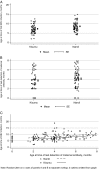Early age at time of primary Epstein-Barr virus infection results in poorly controlled viral infection in infants from Western Kenya: clues to the etiology of endemic Burkitt lymphoma
- PMID: 22301635
- PMCID: PMC3282570
- DOI: 10.1093/infdis/jir872
Early age at time of primary Epstein-Barr virus infection results in poorly controlled viral infection in infants from Western Kenya: clues to the etiology of endemic Burkitt lymphoma
Abstract
Background: Infection with Epstein-Barr virus (EBV) early in life and repeated malaria exposure have been proposed as risk factors for endemic Burkitt lymphoma (eBL).
Methods: Infants were enrolled from 2 rural sites in Kenya: the Kisumu District, where malaria transmission is holoendemic and risk for eBL is high, and the Nandi District, where malaria transmission is limited and the risk for eBL is low. Blood samples were taken from infants through 2 years of age to measure EBV viral load, EBV antibodies, and malaria parasitemia.
Results: We observed a significantly younger age at time of primary EBV infection in children from Kisumu compared with children from Nandi (mean age, 7.28 months [±0.33 SEM] in Kisumu vs 8.39 months [±0.26 SEM] in Nandi), with 35.3% of children in Kisumu infected before 6 months of age. To analyze how different predictors affected EBV viral load over time, we performed multilevel mixed modeling. This modeling revealed that residence in Kisumu and younger age at first EBV infection were significant predictors for having a higher EBV viral load throughout the period of observation.
Conclusions: Children from a region at high risk for eBL were infected very early in life with EBV, resulting in higher viral loads throughout infancy.
Figures


Comment in
-
Age of infection and risk of virally associated cancers: new clues to an old puzzle.J Infect Dis. 2012 Mar 15;205(6):873-4. doi: 10.1093/infdis/jir871. Epub 2012 Feb 1. J Infect Dis. 2012. PMID: 22301634 Free PMC article. No abstract available.
References
-
- Rainey JJ, Mwanda WO, Wairiumu P, Moormann AM, Wilson ML, Rochford R. Spatial distribution of Burkitt’s lymphoma in Kenya and association with malaria risk. Trop Med Int Health. 2007;12:936–43. - PubMed
-
- Facer CA, Playfair JH. Malaria, Epstein-Barr virus, and the genesis of lymphomas. Adv Cancer Res. 1989;53:33–72. - PubMed
-
- Morrow RH. Epidemiological evidence for the role of falciparum malaria in the pathogenesis of Burkitt’s lymphoma. In: Lenoir G, O'Connor G, Olweny C, editors. Burkitt’s lymphoma: a human cancer model. Lyon, France: IARC Press; 1985. pp. 177–85. - PubMed
-
- de-Thé G, Geser A, Day NE, et al. Epidemiological evidence for causal relationship between Epstein-Barr virus and Burkitt’s lymphoma from Ugandan prospective study. Nature. 1978;274:756–61. - PubMed
-
- de-Thé G. Epstein-Barr virus and Burkitt’s lymphoma worldwide: the causal relationship revisited. IARC Sci Publ. 1985;60:165–76. - PubMed

